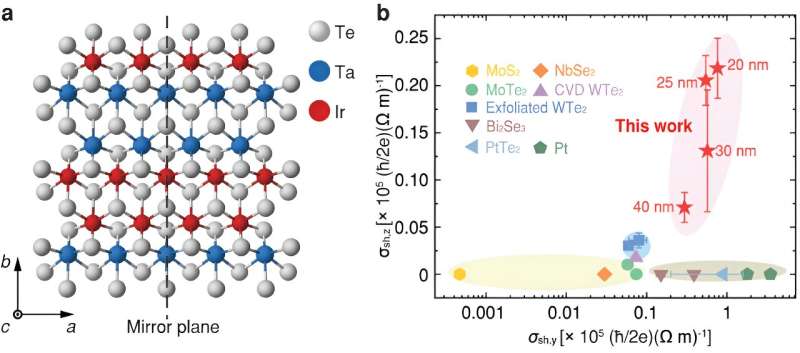November 8, 2023 feature
This article has been reviewed according to Science X's editorial process and policies. Editors have highlighted the following attributes while ensuring the content's credibility:
fact-checked
peer-reviewed publication
trusted source
proofread
Researchers demonstrate field-free switching of a commercial PMA ferromagnet at room temperature

Magnetic random-access memories (MRAMs) are data storage devices that store digital data within nanomagnets, representing it in binary code (i.e., as "0" or "1"). The magnetization of nanomagnets inside these memory devices can be directed upward or downward.
Over the past decade, electronics engineers have introduced techniques that can switch this direction using in-plane electrical currents. These techniques ultimately enabled the creation of a new class of MRAM devices, referred to as spin-orbit torque (SOT)-MRAMs.
While existing techniques to switch magnetization direction of nanomagnets in SOT-MRAMs have proved effective, many only work if external magnetic fields are aligned with the direction of the electric current. In a recent paper published in Nature Electronics, researchers at the National University of Singapore demonstrated the field-free switching of the perpendicular magnetic anisotropy (PMA) ferromagnet cobalt iron boron (CoFeB) at ambient conditions.
"The advent of techniques enabling magnetization switching via electrical currents has led to the commercialization of spin-transfer torque MRAM," Hyunsoo Yang, one of the authors of the paper, told Tech Xplore. "SOT-MRAM is now heralded as the next-generation technology in this field. Specifically, the use of SOT to switch the magnetization of materials with perpendicular magnetic anisotropy (PMA) holds promise for creating efficient non-volatile memory devices."
Many recent studies have tried to overcome the limitations of conventional SOT magnetization switching approaches. Many of the proposed solutions, entail complex manufacturing processes or the incorporation of additional magnetic layers within the structure of MRAM devices, both of which can reduce a device's storage density and lifespan.
"An alternative approach is to employ out-of-plane spins, which can potentially facilitate PMA switching without the need for an external magnetic field," Yang said. "While Weyl semimetals WTe2 has been used for field-free switching at low temperatures, the MRAM practical applications are at room temperature. Meanwhile, the WTe2 is plagued by high power consumption due to their high resistivity. Hence, there is a pressing demand for a more energy-efficient solution to enable field-free PMA switching at room temperature."
Prior studies focusing on MRAM devices demonstrated the potential of attaining PMA switching leveraging out-of-plane spins. They specifically showed that out-of-plane spins can counteract magnetic damping, enabling PMA switching even when no magnetic field is applied.
"This outcome is accompanied by a reduction in power consumption, an assertion supported by our theoretical calculations," Yang explained. "These out-of-plane spins can be produced within materials characterized by a lack of lateral inversion symmetry as shown in Fig. a above, signifying that the requisite conditions for their emergence are tied to the material structural properties."
Inspired by previous efforts in the field, Yang and his colleagues set out to leverage out-of-plane spins to enable the magnetic field-free switching of a commercial PMA ferromagnet at room temperature. They ultimately succeeded using out-of-plane spins sourced from the Weyl semimetal tantalum iridium telluride (TaIrTe4).
"Our accomplishment is substantiated through the bilinear magnetoelectric resistance and spin-torque ferromagnetic resonance measurements, validating the presence of out-of-plane polarized spins," Yang said. "An assessment of the out-of-plane spin canting angle approximates it to be 8°–20°. Remarkably, the spin Hall conductivity of TaIrTe4 is estimated at 5.44 × 104 (ћ/2e) (Ωm)-1, signifying a substantial increase of nearly one order of magnitude compared to WTe2."
The recent findings gathered by Yang and his colleagues highlight the potential of TaIrTe4 as a source of spin current to enable field-free SOT induced PMA switching. In the future, their work could inspire other research teams to experiment with this material, thus opening interesting new avenues for the development of SOT-MRAMs.
"In this work, we initially obtained TaIrTe4 flakes through mechanical exfoliation from a single crystal," Yang added. "Nonetheless, for industrial purposes, it is imperative to produce extensive films via techniques compatible with large-scale production. These films must simultaneously exhibit the requisite crystal asymmetry necessary for the generation of out-of-plane spins."
More information: Yakun Liu et al, Field-free switching of perpendicular magnetization at room temperature using out-of-plane spins from TaIrTe4, Nature Electronics (2023). DOI: 10.1038/s41928-023-01039-2
© 2023 Science X Network




















